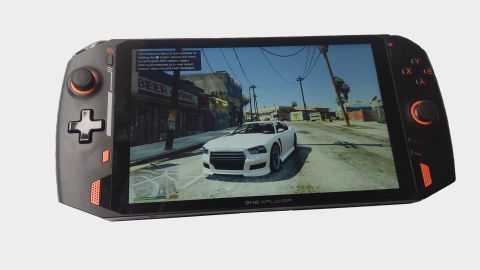Our Verdict
The Onexplayer fits neatly into the handheld gaming PC niche but needs to do a lot more to break into the mainstream.
For
- Awesome high-res display
- Impressive core specification
- Versatile and flexible
Against
- Integrated GPU lacks oomph
- Way too expensive
- Fans get noisy
- Windows 10 isn't built for handhelds
PC Gamer's got your back
The Onexplayer is a bit of an oddity in the world of PCs, in that it's a handheld touchscreen PC with built-in gamepad controls. Think of it as a high-end Nintendo Switch, but running Windows, and constructed out of PC hardware that you know and love, and you're not far off.
Born out of an incredibly successful Indiegogo campaign, that saw it reach $1 million in funding in its first day, the Onexplayer comes in a variety of SKUs depending on what sort of CPU you want it built around. The launch models all use Intel's 11th-gen Tiger Lake CPUs, which feature Iris Xe graphics cores.
Specifications
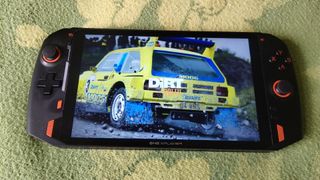
CPU: Intel Core i7 1165G7
GPU: Intel Iris Xe (96 EU)
RAM: 16GB DDR4-4266
Storage: 512GB PCIe 4.0 SSD
Display: 8.4-inch IPS, 358 PPI
Resolution: 2560 x 1600
Connectivity: 2x USB 4.0 Type-C, USB 3.0 Type-A, 3.5mm audio
Battery: 59Wh
Wireless: Wi-Fi 6, Bluetooth 5
Size: 288 x 130 x 21mm
Weight: 820g
There are currently two models available—one based on the Intel Core i5 1135G7 with a 512GB SSD and the other using an Intel Core i7 1165G7 with a 1TB SSD. Another model, using the Core i7 1185G76 and with a 2TB SSD, is also in the works. The Core i7 chips have 96 execution units (EU) in the graphics cores, while the Core i5 gets by with just 80.
The unit sent in for review is a bit of an oddity in that it uses the four-core, eight-thread Core i7 1165G7, but only has a 512GB SSD. So it's not quite a model you can buy, although it is fine for assessing how the machine handles modern games.
One-netbook, the company behind the Onexplayer, has done a good job on the rest of the core specifications, with 16GB of DDR4-4266 RAM, speedy PCIe SSDs, an 8.4-inch display with a native resolution of 2560 x 1600, analogue controllers on either side of the screen along with a classic XYAB button layout on the right, as well bumpers and triggers.
There are also a pair of speakers, although they are tiny and a bit tinny—they're not great, although have you covered in a pinch. You're better of plugging in some headphones wherever possible if only to combat the noise of the fans battling to keep the handheld cool—a big noisy ask when you're gaming.
As the handheld uses Intel's Tiger Lake CPUs, it means you get access to some juicy next-gen tech like Wi-Fi 6 and USB 4.0 support, which means you'll be able to plug this straight into a 4K display or an external GPU dock in the future. A monitor with a USB dock is a great companion for this machine to be sure, but we'll get to that shortly.
The Onexplayer uses a standard installation of Windows 10 as well, which means you can use it for everything you'd use any PC for. And there's no problem running all the software and games you know and love because, despite its unusual form factor, it's just a PC as far as the software is concerned.
Interface
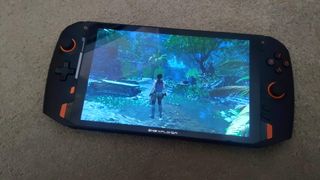
Unfortunately, there are problems with the Onexplayer, with Windows 10 being an obvious weak link once you actually start using the device. Not utterly concept breaking, but despite its attempt to straddle multiple forms of input, Windows 10 still doesn't make for a silky smooth experience when it comes to touch or controllers. And here you're going to bump up against the frustrations of both.
Steam Big Picture mode feels pretty much essential here, as it offers up a simple interface that doesn't rely on a mouse for the simplest of operations. Obviously, that only works for games that you have on Steam, which isn't quite the catch-all that it once was, but it's better than nothing. You can also add non-Steam games to the interface, although this can be janky at times as well.
Anyway, does the familiarity and versatility of the world's most popular OS counter its shortcomings? Probably, but there are times when it feels like you're a Linux user back in the day, having to resort to arcane methods just to do whatever simple task you're trying to achieve. Admittedly we're not quite talking command line tweakery here, but plugging in a keyboard to get back to full-screen mode, or a mouse just to get through a configuration screen quicker does feel at odds with what a handheld gaming experience should be like.
This does highlight one of the positives of using Windows on the Onexplayer though, and that is it is fundamentally a standard PC. The lone USB Type-A port at the top of the device allows you to plug in all manner of peripherals, and they'll just work. You'll find a pair of USB 4.0 Type-C ports up here as well, which can be used for charging or for connecting newer peripherals.
Want to do some work on it, or play a text adventure and don't fancy fighting with the laughably fiddly On-Screen Keyboard? Go for it. USB headphones? Sure. Mouse? No problem. External Storage? Why not.
I've even hooked it up to a docking station in the office and enjoyed some big-screen gaming with the dock providing ridiculously fast internet access and ample ports for a keyboard and mouse as well. The Onexplayer can be an incredibly versatile device with the right peripherals and could allow you to play and work from one compact box.
Gaming
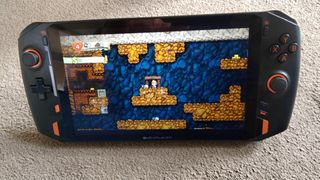
So, what's it like to game on? Well, that depends on the game, and whether the Onexplayer has the raw performance to actually handle whatever it is you're trying to do. It's important to note that you're on integrated graphics here, and as such, the very latest triple-A games are going to struggle, especially at the screen's native resolution of 2560 x 1600.
For the most part, when gaming at least, you're going to be running at 1280 x 720. 1280 x 800 is actually a better option, as that's half the resolution of the screen, although not every game supports it. You may get away with running at 2560 x 1600, although the lack of dedicated memory on the GPU is the thing that will hold you back the most, and is the reason we saw errors pop up in the likes of Horizon Zero Dawn at launch.
Intel's integrated graphics have come a long way, and at 720p this is capable of playing plenty of games at reasonable framerates. Shadow of the Tomb Raider at low settings averages out at 35fps, while GTA V managed 60fps at the same resolution, again with the settings dialled down. You can even push GTA V at the native resolution, although the framerate can drop to 18–20fps when you do so, which isn't the smoothest experience.
Games that are made for controllers work best, which is a good enough excuse to return to the likes of Spelunky, Braid, and Dirt Rally. The fact that these are all older games works in the machine's favour as well, and I had no problems with their framerates, especially after a little setting tweaking for Dirt Rally.
Forza Horizon 4 showed that it isn't just about the framerate though, as there were glitches in the game regardless of the settings used. You'll also struggle to get some games running smoothly no matter how much you try tweaking them—Cyberpunk 2077 for instance did not make for a good experience, even at lower resolutions and graphical settings.
There are other problems as well—driving games suffer from overzealous rumbling from the twin vibration motors. Dirt Rally started rumbling the moment I put my foot down (well finger) and didn't let up until I'd finished the race. It's a crude, first-gen console level of rumble too, you know the noisy kind that assaults your ears as much as your fingers. Not pleasant.
Card games work well, with Magic the Gathering Arena and Hearthstone both putting in good shows. To be fair, MtG Arena has recently made its way over to phones, so the interface has been designed with that in mind, and Hearthstone has also been built with touch in mind. But pulling out this machine for a quick game or two worked really well, and gave me a real glimpse of why I would want to use this on a daily basis.
You can play first-person shooters on it as well, particularly as they tend to offer decent performance even on lower hardware. I'm really not going to swap the precision of a keyboard and mouse for console control though, so this isn't something I'd spend much time with anyway. And while you can hook up a keyboard and mouse to do so, at some point you've got to realise you're not really using it as a handheld gaming PC anymore.
Conclusion
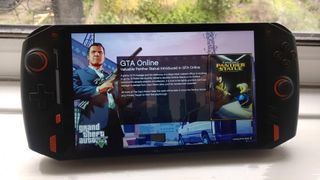
The fact the Onexplayer is a full PC, with all the versatility and compatibility that comes with running Windows 10 ultimately works in its favour. Microsoft's OS can make for a clunky touch interface though, especially when you're just trying to get a game up and running, and it often doesn't feel like the premium solution it should be capable of. It does mean that the full wealth of PC gaming is open to you though, and that's probably worth having to jump through a few hoops to enjoy.
There's no getting away from the fact that $1059 (the cheapest unit's full price) is a hell of a lot of money for a device that relies on integrated graphics. I'd want a lot more graphical bang for my buck to really consider buying this, but the potential is undeniable, even if it isn't quite the perfect solution for every game or every gamer. I've got no interest in playing first-person shooters on it, for instance. But in games where the joypad controllers make sense, this is a neat solution.
This kind of money can buy you a powerful desktop PC (if you could actually buy the components), or more fairly, a pretty decent gaming laptop with an Nvidia GPU. But neither of those offers quite the same experience that this does—a touchscreen handheld gaming machine that's great to pick up and just play with. It feels like there's a place for it in the PC gaming landscape, and that should be seen as a success, even if this version isn't quite there yet.
I really want to love the Onexplayer. It does so much right. But it pulls up a bit too short in the graphics department for my tastes. It feels like One-netbook believed Intel's hype for its Xe graphics in Tiger Lake a bit too much. If we could get this packing AMD's rumoured Zen 3 and RDNA 2-powered Rembrandt APUs, then I'd be a lot more interested—although they're not due until the start of 2022, so I'm going to have to wait for that.
The Onexplayer fits neatly into the handheld gaming PC niche but needs to do a lot more to break into the mainstream.
Alan has been writing about PC tech since before 3D graphics cards existed, and still vividly recalls having to fight with MS-DOS just to get games to load. He fondly remembers the killer combo of a Matrox Millenium and 3dfx Voodoo, and seeing Lara Croft in 3D for the first time. He's very glad hardware has advanced as much as it has though, and is particularly happy when putting the latest M.2 NVMe SSDs, AMD processors, and laptops through their paces. He has a long-lasting Magic: The Gathering obsession but limits this to MTG Arena these days.

LG's bizarre but impressive stretchable prototype display has the 'highest rate of elongation in the industry,' a measurement I had no idea existed

It only took 8 years and an orchestral jazz cover but one of the funkiest Persona 5 songs finally got nominated for a Grammy

Steam's latest update promises better betas, barely a bundle of broken save games
